Search engine optimization (SEO) is one of the most technical marketing strategies for interior designers to tackle—but it’s also one of the most effective.
It can be daunting to learn all about keyphrase research, meta descriptions, and backlinks. But if you don’t dive into the world of SEO, you can be sure your local or niche competitors will. Designers who rank in Google for relevant searches are able to drive a steady stream of targeted traffic to their website, picking up high-quality leads on the regular.
The good news is, you can do SEO by yourself (no expensive marketing agency required). In this guide, we walk you through 10-must know SEO strategies for interior designers—whether you serve clients locally or internationally.
Table of Contents
How can SEO help interior designers?
SEO can significantly benefit interior designers by enhancing their online visibility, making it easier for potential clients to find them.
By optimizing your website with relevant keywords, high-quality images, and helpful content, you can attract more traffic from search engines like Google. Effective SEO strategies improve the website’s credibility and authority, which can lead to both higher search rankings and increased trust from potential clients.
Local SEO tactics help interior designers target clients in specific geographic areas, boosting the likelihood of acquiring local projects. Ultimately, a strong SEO presence can lead to more inquiries, bookings, and a thriving business.
11 interior design SEO strategies that work
Take a closer look at the strategies that will get your interior design site ranking in Google.
1. Target keyphrase research
Before you optimize your website for target search terms, you first need to research those keywords and make sure that they actually have some recorded search volume.
The first step is to use an SEO software. Ubersuggest is a free SEO tool designed for small businesses. You get 3 searches per day on the free plan.
So, what are the best SEO titles for interior designers? These should usually match your title. So if you offer e-Design services and you call yourself a farmhouse interior designer, then that’s what you’d want to rank for.
As we can see, “farmhouse interior designer” gets about 40 searches per month (in the United States — Ubersuggest only shows national search volumes, not global). That might not seem like a lot. But remember, many of those searchers are actively looking to hire, so just getting a few of them to fill out your lead form could bring in a lot of extra revenue.

However, location-based keyphrases tend to have a lot more search volume than niche ones. As we can see, “interior designer austin” has 1,000 searches per month. So, if you’re choosing between a niche keyphrase and a local one, you should prioritize the local one. (You can choose both. More on that in Step 2.)

Once you’ve double checked that your target keyphrases actually have recorded search volume, you’re ready to add them to your site.
If your niche or location is likely to change, be careful about optimizing your homepage for your target keyphrases, because if you remove them from your homepage, you will lose all of your rankings.
The vast majority of designers will be better off placing their main target keyphrase in the homepage of their website, because of the way that PR affects SEO (discussed in Step 5).
Contrary to popular belief, this doesn’t have to affect your branding. Take a look at Kerrie Kelly’s website. She doesn’t put her target keyphrase in the hero (top) section of her website, and yet she still ranks for “Sacramento interior designer.”
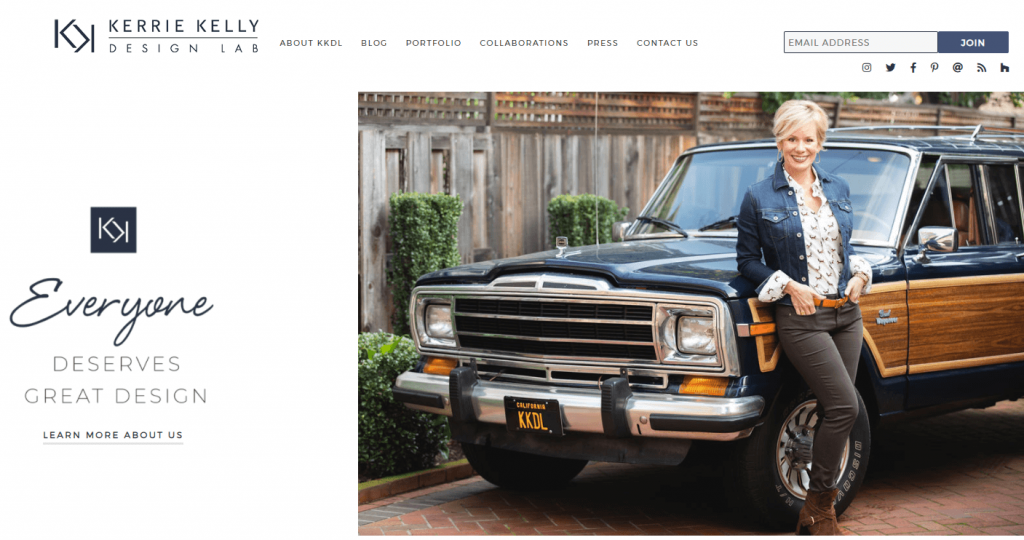
Her target keyphrases are actually in the third section of her website. She includes both “Sacramento” and “Northern California” in the section about her interior design services.
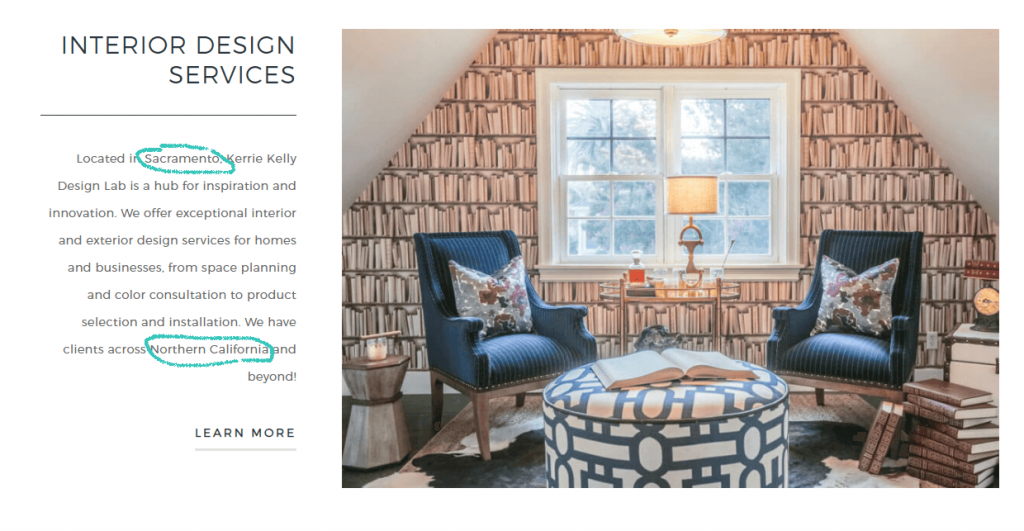
Kerrie Kelly’s website ranks not only because of these keyphrases, but also because of her amazing publicity.
Should your keyphrases go on your homepage? They don’t have to. If you have multiple niches, you could put your target keyphrases on service pages. For example, you could have one page targeting “interior design San Diego” and another targeting “staging San Diego.”
2. Competitor research
If you’re struggling to find keyphrases to rank for, just pop your competitors’ websites in Ubersuggest, Mangools, Ahrefs, or your favorite SEO tool. You can probably think of some fellow designers on Instagram who serve a similar niche as you.
You’ll instantly pull up a list of all of the keyphrases that their websites are ranking for. Add the ones that appeal to you to your list of target keyphrases.
You can also create another tab on your spreadsheet of keyphrases and add your competitors’ websites there. Every six months or so, you could review their websites again and analyze them for any new rankings to help inspire your website pages or blog posts.
3. Website page optimization
If you don’t put your target keywords in your website, then Google won’t be able to rank you.
You need to enter your keyphrases on the front end and the back end of your website.
- Front end (what viewers can see) – Add your target keyphrases in headlines and body copy in your site. For example you could have a headline that says “Award-winning Seattle interior designer” and then you could have an “about” section on your homepage that says. “Based in Seattle, Chic Life Labs is an interior design studio for busy professionals who want to love where they live.”
- Back end (website administrator controls) – In the back end, you need to add your keyphrase in the document title, meta description, and target keyphrase fields. Any website builder should have these fields, but sometimes they have a different name, so if you’re not sure, contact customer support. A document title (the title of the page) would be something like “Chic Life Labs | Seattle Interior Designer” and a meta description (140 characters or less) would be “Based in Seattle, Chic Life Labs is an interior design studio for busy professionals who want to love where they live. Explore our services.” For the target keyphrase section, you should enter the 2-4 word keyphrase you’re going for, such as “Seattle Interior Designer.”
Luckily, there are plugins that make all of this even simpler.
Rank Math SEO is a free plugin for WordPress websites that makes it easy to add the target keyphrases in the back end of your website. It also gives you a checklist of SEO actions to do, and if these aren’t done yet, you’ll see a red X next to them.
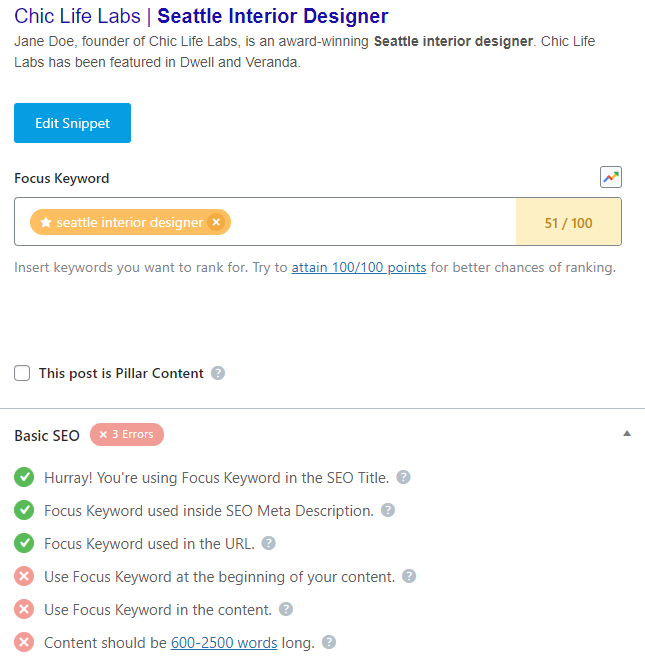
If you are SEO-optimzing a new page (not your homepage), then make sure that the URL of that page matches your target keyphrase exactly. For example, a landing page URL might be chiclifelab.com/seattle-interior-designer.
4. SEO blogging
Blogging shows Google that your business is active while also building up topical authority. What is topical authority? Simply put, Google is more likely to rank websites that have lots of content around a certain topic, rather than a website that put up a single SEO-optimized landing page and then didn’t write anything else. It makes sense when you think about it!
So, even if your individual blog posts don’t rank for their target keyphrases, as long as they are relevant to your business, these blog posts can still be useful in ranking your homepage, services pages, or location pages.
Even though your individual blog posts don’t have to rank in order to have an impact on your SEO, it’s still wise to SEO-optimize most of your blog posts. Seek to find a keyphrase for 70-80% of your blog posts.
For example, if you want to write about a specific trend, such as jewel tones, then you could hop over to Ubersuggest and see if there’s any recorded search volume for that idea. “Jewel tone interior” has 140 searches per month.
Put the target keyphrase in the title of the blog, meta description, URL, in a subheading, and in a couple of paragraphs (but don’t overstuff it).
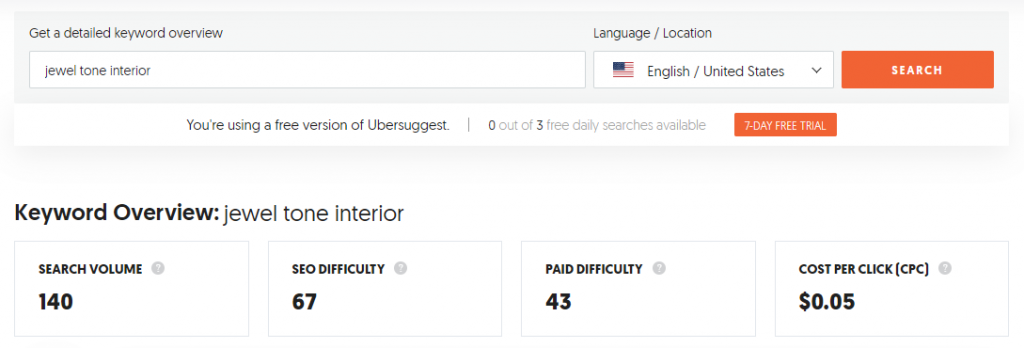
By doing your keyphrase research, you give yourself a shot at ranking in even more Google searches, which could lead to projects and media inquiries.
But, if you get a fun idea that has nothing to do with SEO, go for it. Your blog is a place to build your topical authority and your brand. In this example, a team of interior designers share summer inspiration.
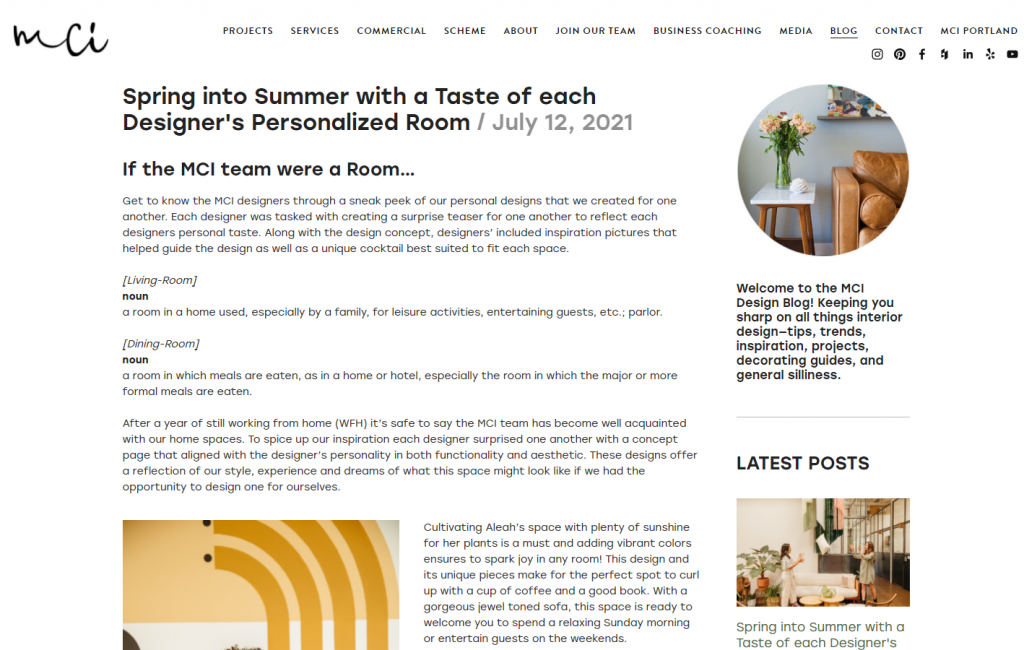
5. Digital PR
Wait what?! You’re telling me PR impacts SEO?!
Yup, that’s exactly what we’re telling you.
- (SEO) What you say = Putting keyphrases in the front end and back end of your website is the same thing as you telling Google what you want to rank for.
- (PR) What other people say = Digital PR in the form of media features, guest blogs, podcast interviews, and conference speaking engagements all act as ways for other websites to validate your authority and offer a seal of approval in Google’s eyes.
To rank for competitive keyphrases, you need both SEO and PR.
You need to tell Google what you want to rank for, and you need trusted websites linking to you. When another website links to your website, it’s called a “backlink.” Quality backlinks tell Google that you’re a true expert.
There are so many ways to get backlinks from digital PR. And the good news is that this also builds your brand and drives traffic and leads!
Below, we’ll take a look at some of the different options.
You could get featured in a round-up like this. It’s an article from The LowDown showing their top interior designer picks from every US state.
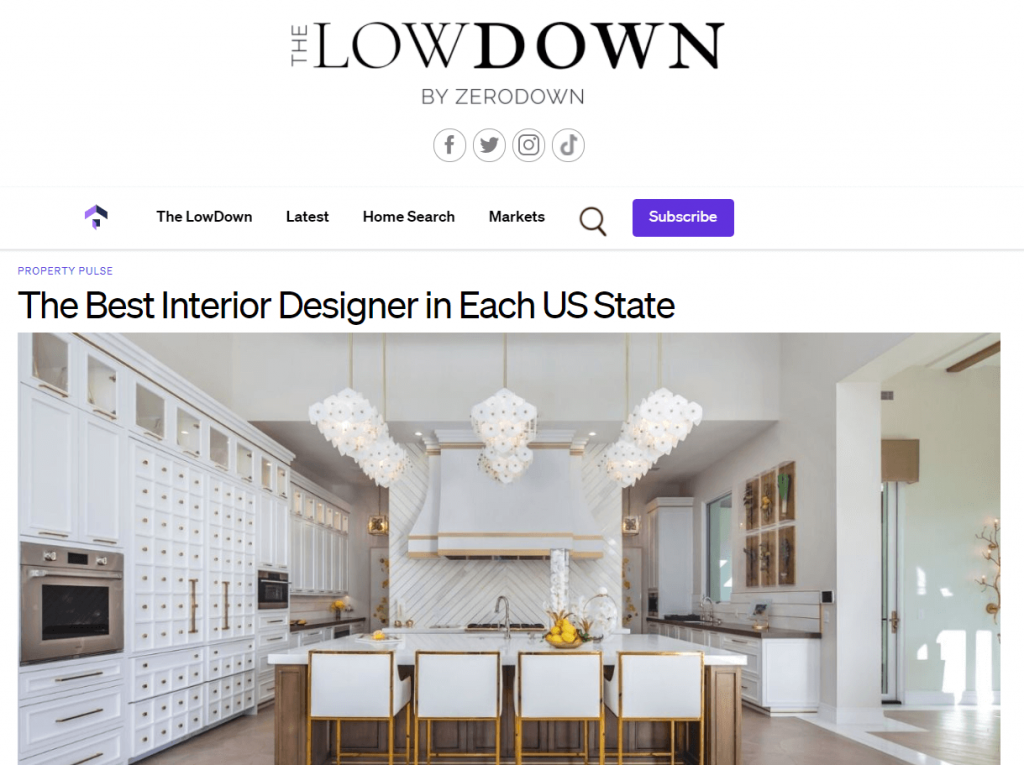
Anchor text is a fancy schmancy way to describe the word or phrase that your site is linked from. Here are two examples of anchor text from that article:
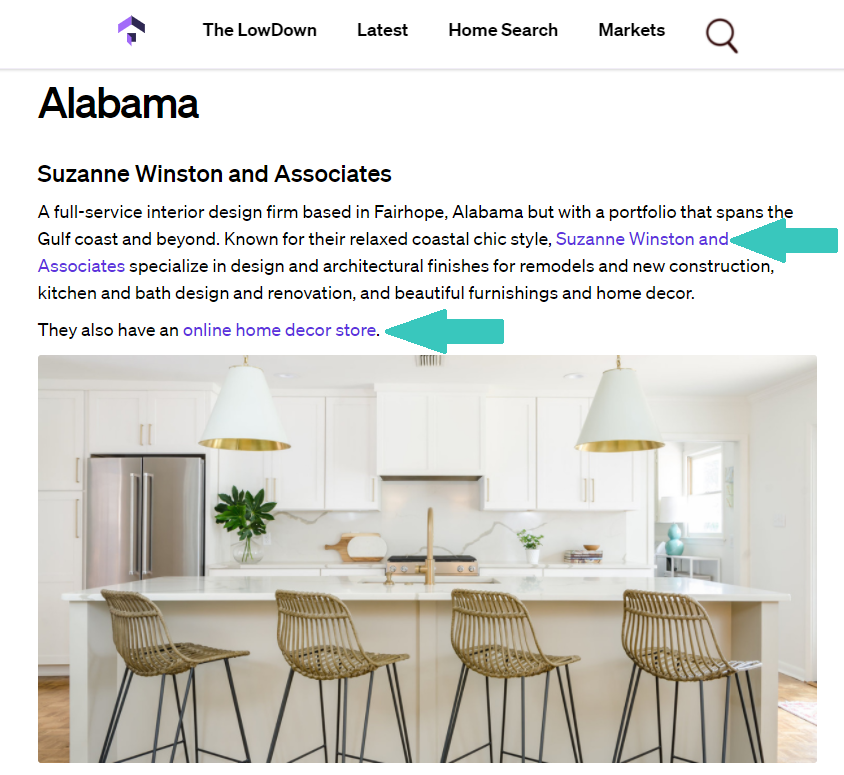
For most quotes and features, you will get linked to from the name of your business. So if your business is Chic Life Lab, then that is most likely the phrase that the journalist will use to link to you.
Those types of links are great, but as you go along, you should also try to build backlinks with even more specific anchor text. For example, if you want to rank for “Seattle interior designer,” then you could ask a podcast host to link to your website with that anchor text. Or, if you’re writing a guest post, you could link to your website in the body of the post or from your guest author bio.
The most important thing is to get some high quality backlinks, regardless of the anchor text. So if you’re having a hard time getting other websites to link to you from “Seattle interior designer” instead of “Chic Life Lab,” don’t worry about it too much.
So how do you get these media features?
You could use Connectively (formerly Help a Reporter), a place journalists go to find sources. Sign up for the daily emails and scan through them (or have your assistant scan through them) to find relevant journalist queries and answer them with a thoughtful response.
For example, a journalist might write “Looking for Interior Designers’ Top Tips for Elegant Holiday Decor.” Journalists receive lots of responses, so think outside of the box before writing your answer. In your email response, make sure you put your unique tip or idea in the subject line of your email so it stands out. If you’re selected, the journalist will almost always link back to your website when quoting you.
Here’s an example of an interior designer being featured in a local magazine. This is great because you get the local press, plus you get a quality backlink showing Google that you are a local interior designer in Sonoma.
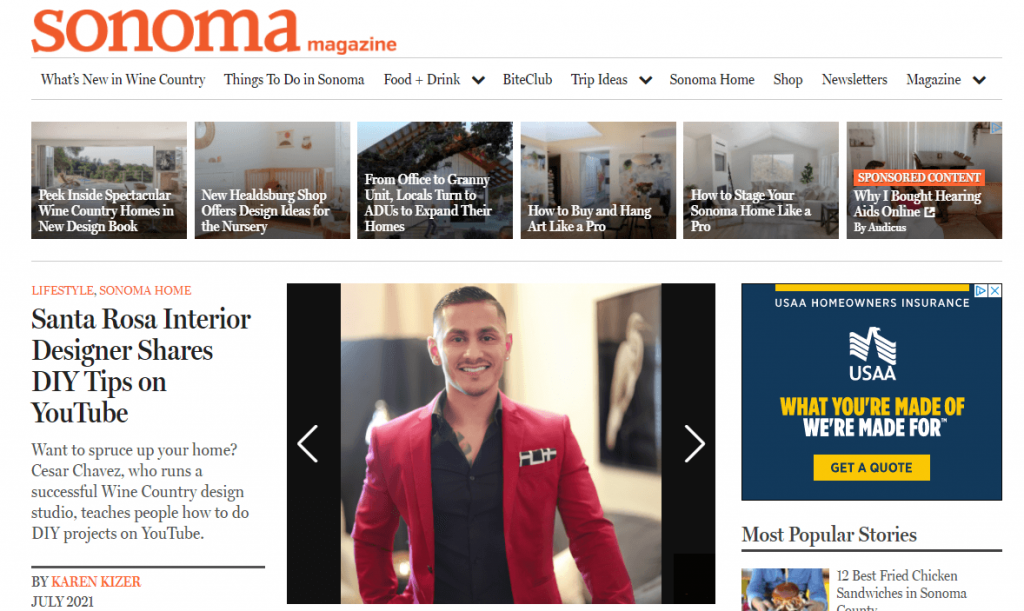
You don’t have to wait for this sort of press to come to you.
You could reach out to local journalists directly, and also journalists who write for design and lifestyle magazines. Keep in mind that it’s easier to get featured in digital media versus print media.
Every media company will have a masthead with contact information:
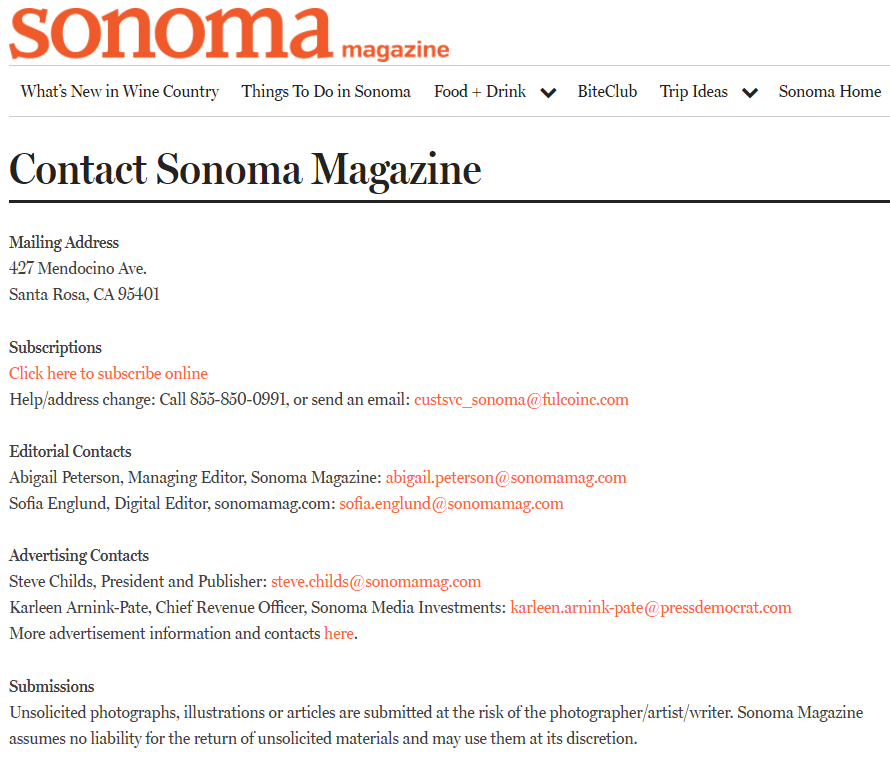
If you find a writer on the site who already covers businesses like yours and who would be perfect to feature you, but you don’t see them in the masthead, you could use a tool like Hunter.io to find their email address for free.
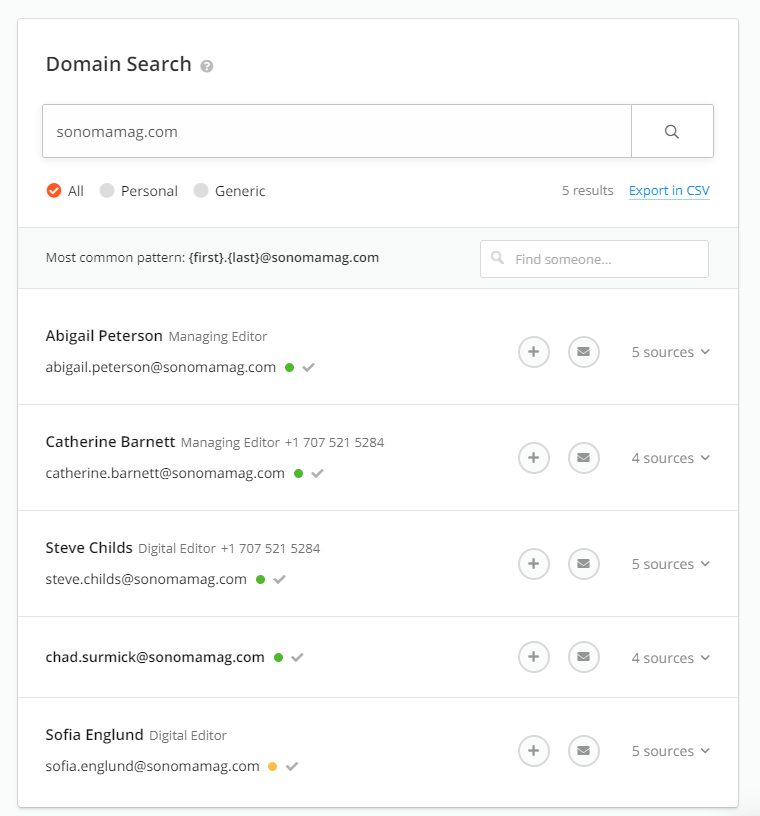
Then, send them an email pitch. Here’s an example:
Subject line: Pitch – Seattle area designer on locally inspired living spaces
Hi Catherine,
As a Seattle-based interior designer, clients often want spaces that give a nod to our local history and environment without being too kitschy or touristy. I’ve created dozens of living spaces for local clients that elevate the Seattle style.
I’d be happy to share my tips for DIY homeowners, along with plenty of photos for inspiration.
I have 10 years of design experience in Seattle and surrounding areas, and my business has previously been featured in The Spruce and House Beautiful.
Does this story appeal to you?
All the best,
[Your signature]
Make sure you always have a unique angle. Whether that’s to highlight a recent success, share unique tips, or appeal to a local audience. Include that unique angle both in the subject line and body of your email.
A short 1 – 2 sentence description of yourself shows the journalist that you’re an expert on the topic. If you don’t have previous features, then simply talk about your design experience, how many years you’ve been in business, and the types of clients you serve.
You could also search #journorequests to find relevant queries.
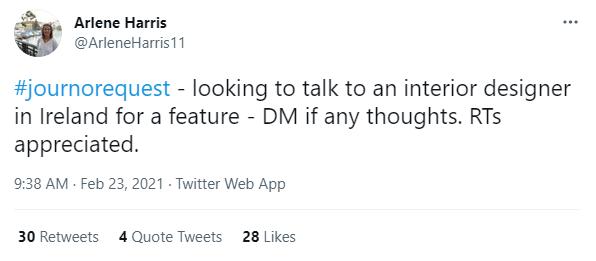
Typically, you can only DM someone if you are following each other, so if you want to share your answer, then simply comment on the tweet, with something like, “I’m an interior designer based in Dublin, Ireland with 10 years of experience. My business has previously been featured in The Spruce and House Beautiful. I’d love to help!”
Podcasts are another way to build quality backlinks to your website. You could use a tool like PodBooker or Postaga to make it easier to find and pitch podcasts.

Make sure to do some competitive research too. Find out what podcasts other designers have been featured on by searching for designers names that you admire along with the word “podcast” in Google.
Aim to apply to both local spotlights and guide podcasts and design-specific podcasts. When pitching design podcasts, make sure to include a unique angle that you would talk about on the show, like a specific trend or tip. But when pitching a local podcast that features business owners, you can simply pitch the fact that you are a local designer, and also mention a few different ideas for what you could talk about on the show.
If you are trying to rank a services page (not your homepage), you should try to get backlinks to that page too, not just your homepage. You can do this by writing guest blogs and linking to that page in the text, or by asking a podcast host to link to that page from the show notes instead.
6. Online reviews
Just like backlinks, Google reviews are another thing that Google uses to determine if your site is worth ranking higher than others. Google reviews are important because they increase your chances of showing up in Google Maps. For local-intent keyphrases, Maps results are at the top of the page. Google reviews are especially important for designers wanting to rank for location-based keyphrases like “interior designer Seattle” but they can also help you rank for niche-based keyphrases like “Victorian interior designer” because Google will show nearby interior design businesses based on the searcher’s location.
You don’t have to have tons of reviews to show up in Google Maps, but lots of reviews make it more likely that you will show up there.
If you want your business at the top of search results for local queries, then you need to get as many positive online reviews as possible.
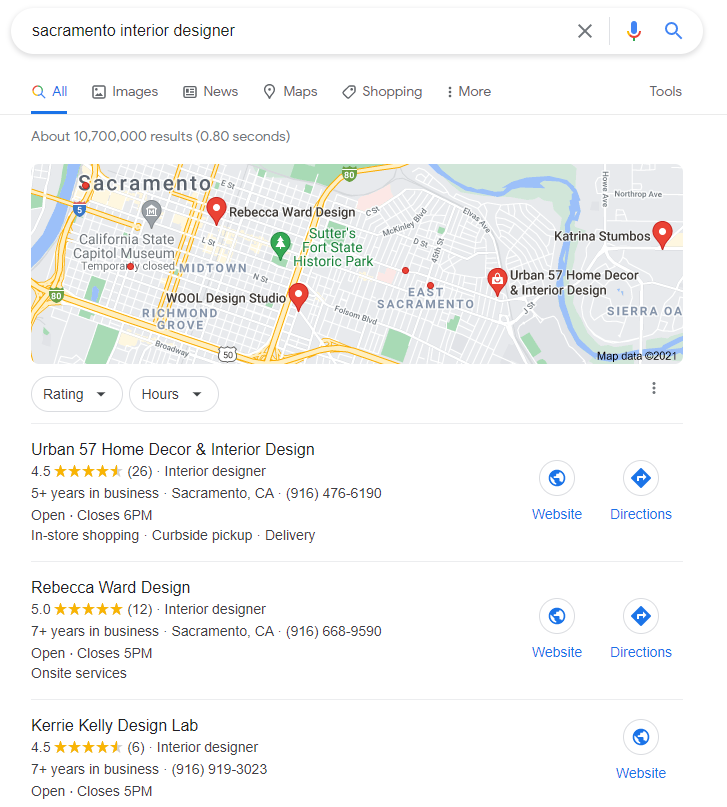
It’s worth noting that searchers don’t even need to type their city for Google to show Maps. If you search “interior designer” (without adding your city name) on your computer or phone, Google will still show local results, as long as you’re signed in to your Gmail account, or Google has permission to know your location.
This is one of the easiest parts of SEO. Just ask your clients for reviews! Make sure to ask clients who you know were satisfied with your services.
Here’s an email template you could modify:
Subject line: Quick request for a Google review (it matters a lot)
Hi Claire,
I loved working with you, and am so happy your dream living room came to life!
I have one quick favor to ask: would you write me a Google review?
This helps other potential clients trust me, and it has a big impact on getting my website to rank in Google search results — which is a goal of mine.
If you’re willing, here’s the link to leave me a review: [your Google My Business page link]
Thanks so much! And feel free to let me know of any questions.
[Your signature]
7. Rank tracking
You’ll want to find out if you’ve actually ranked for anything yet. If you are, this will change your approach, which we explore below and in Step 8.
Here’s how to find out if you are ranking for anything. Head over to Ubersuggest and type in your website domain name, such as summerthorntondesign.com.
Then, scroll down to the “SEO Keywords” section to find out what you’re ranking for and in what position. Keep in mind that Google is an algorithm, and rankings and positions can change daily, so Ubersuggest isn’t always 100% accurate in terms of the exact position.
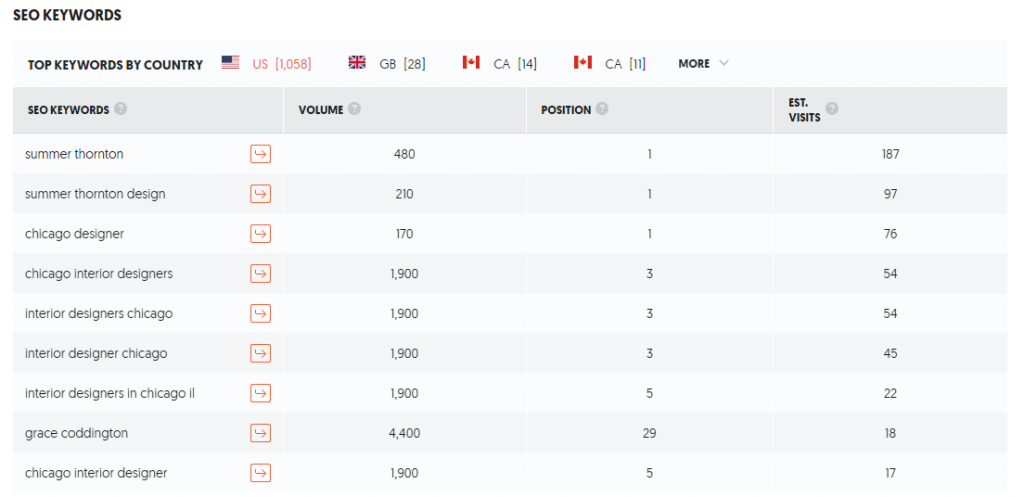
You can also manually do a Google search and see if you can spot your website on Page 1.
If you are ranking for your target search terms on Page 1 of Google, congratulations! You can move on to Step 8.
If you haven’t ranked yet — or if you’re ranking blog posts but not your homepage or services page yet — you’ll want to keep working on getting backlinks and Google reviews. You might also double check that your front end and back end keyphrase targeting was done correctly.
Just because you rank for your ideal search now, doesn’t mean you will forever. The good news is that Google doesn’t want extreme volatility in their search ranking pages. It’s not a good user experience for things to be changing all the time. People use Google to find things, so wild and constant fluctuations would be annoying. That means that once you rank, Google is happy to keep you there as long as you do your part to stay.
At this point in the game, you’re now in defense mode.
Essentially, you’ll want to keep doing all of the steps above, you can just do them less frequently. So, if you’ve been blogging monthly to build up your topical authority, you can now blog quarterly. If you’ve been strategically building two backlinks each month to your website, you can switch to two backlinks each quarter.
If SEO becomes a key driver of business (if clients say that’s how they found you), then you might want to upgrade to a more advanced SEO tool. Leave Ubersuggest behind and sign up for Ahrefs instead.
You can use the “Movements” feature to track your shifting and lost rankings.
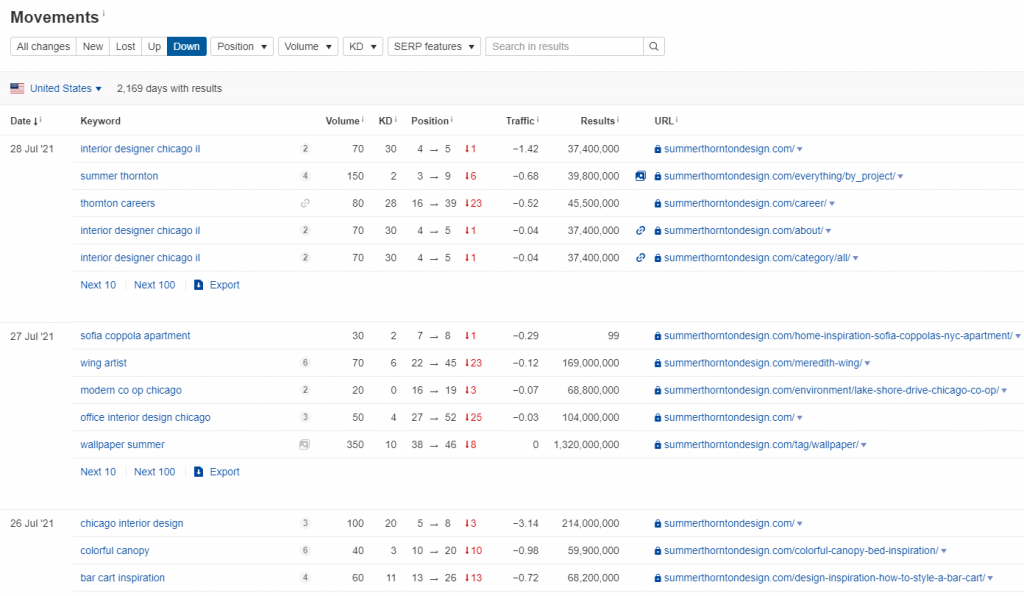
Some of the decreasing rankings will be irrelevant terms that you are on page 10 for, but some might be your most valued keyphrase (like Seattle interior designer).
If you don’t want to pay for software, you can also just manually search your website every month for your top searches and see where your website is ranking.
If you find that you’re losing important rankings, then you should update your home page and services page with some fresh text and images, publish a new blog post related to your target keyphrase, and drive a couple backlinks to your website.
8. Driving backlinks
In our section above on digital PR, we covered how you can utilize online publicity to drive backlinks to your website. Backlinks act like votes of trust that encourage the Google algorithm to choose your website over others. Especially when it comes to small businesses competing for local design or niche design phrases, backlinks can be a major factor in helping you pull ahead.
When combined with the page optimization strategies mentioned above, even just a few high-quality backlinks can help your website soar to the top spot.
Digital PR isn’t the only way to drive backlinks. In fact, there are easier ways to go about it.
You could purchase backlinks from reputable guest blogging companies like OutreachMama or OneLittleWeb. These companies publish guest posts on other websites and include a link to your site for a fee. If you use this strategy, choose websites with a high domain rank (over 60) and be sure to specify the anchor text.
As mentioned above, the anchor text refers to the text that is linked. So if you want to rank for “nursery designer,” you would ask that the guest blogging company to use “nursery designer” as the anchor text in their article and to link to your services page that is optimized for that keyphrase.
Buying backlinks can be a gray area, so be sure to layer this strategy with digital PR.
You can also offer backlink swaps. You might reach out to local furniture stores or interior designers who aren’t your direct competition. Ask them if they’d like to swap backlinks, and if they agree, check their blog for areas where you could naturally insert your link. Submit your request in this format:
- From URL:
- To URL:
- Anchor text:
It’s normal for related websites to interlink with each other, but again make sure to layer this strategy with some of the other link building methods mentioned, so you don’t only have a bunch of swaps.
9. Internal linking
Links within your site are just as important as links from other websites. Internal links between your posts and pages tell Google about the structure of your website and help you build up your topical authority.
Make sure to link blog posts to relevant website pages. For example, if you have a services page about nursery design, you might link to it from a blog post on nursery design trends. Use the ideal anchor text. So you might say something like, “As a nursery designer,” at the start of a sentence and link to your services page from the text “nursery designer.”
10. Indexing URLs in Google Search Console
When you index a URL in Google Search Console, you’re essentially submitting a new or updated URL so that Google knows about it, instead of waiting for the algorithm to crawl your site and pick it up. Indexing allows you to rank your pages faster because you’re submitting your content directly to Google’s search engine.
It’s really easy to do. Just click here to go to Google Search Console. Then, at the top, where it says “Inspect any URL” paste your blog post or web page URL and hit the enter key on your keyboard. Then select “Request indexing.”
If you’ve never used Google Search Console before, you’ll need to follow the basic setup instructions first:
- Go to Google Search Console website.
- Sign in with your Google account.
- Click “Start now.”
- Enter your website URL.
- Choose a verification method.
- Follow the on-screen instructions to verify your website.
- Click “Verify.”
- Once verified, click “Go to property.”
- Submit your sitemap (if available).
11. Maintain accurate business listings
Listings and directories like Yelp and Thumbtack can be a great source of business for interior designers. Unfortunately, these sorts of websites rank for many interior designer keyphrases, meaning there’s even less space on page 1 of Google results for actual small business owners’ websites.
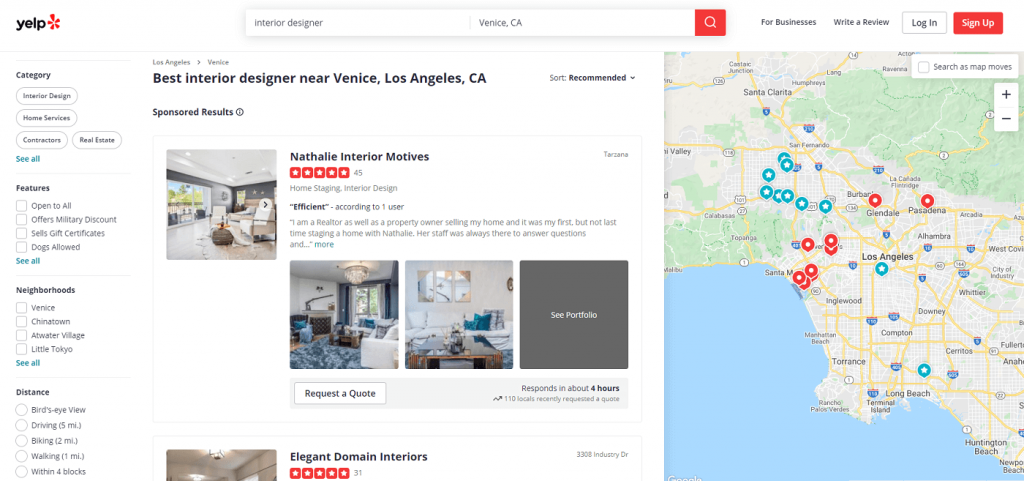
If you live in a smaller town, it’ll be easier to get featured on Google directly, but if you live in a big city, you might have better results trying to rank in one of these directory websites.
The process is similar to what’s described above, but much simpler. You need to create an accurate profile, and make sure your location is in your description. The more positive reviews you have and the more complete your profile, the more likely you are to rank in one of these directories.
If you want to get reviews on these websites and on Google, you could switch off what you ask clients to do. So if you ask one client to review you on Google, ask the next one to review you on Yelp. For your most satisfied and raving clients, you could ask them to review you on multiple sites.
While Yelp and Thumbtack are popular across North America, there might be city or county directory sites that are relevant for you too, so do your research and find out what else is available. Many smaller websites only require your business information, and you don’t have to try to get reviews or continually update your portfolio.
3 examples of interior design websites that rank
For more inspiration, check out these interior design websites and their SEO results.
1. Summer Thornton Design
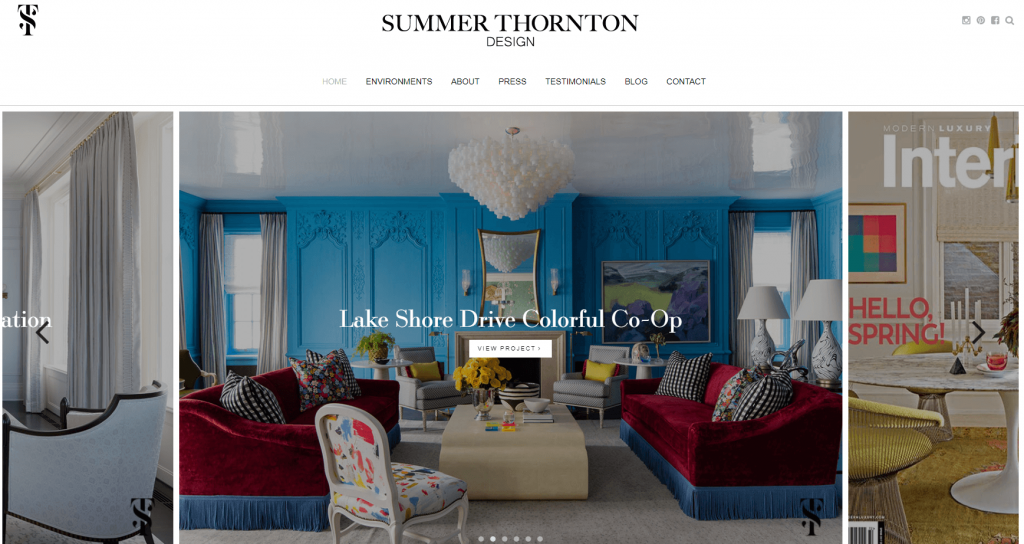
Summer Thornton Design offers full-service design and specializes in traditional, luxury interiors. By optimizing her website for Chicago-related keyphrases, she appears towards the top of results for searchers in her area. Her blog also ranks for several trends and color-based keyphrases.
Keyphrases this website ranks for:
- Interior designers Chicago
- Luxury home designer
- Interior decorators Chicago
- Traditional decorators
- Kelly green and pink
2. Little Crown Interiors
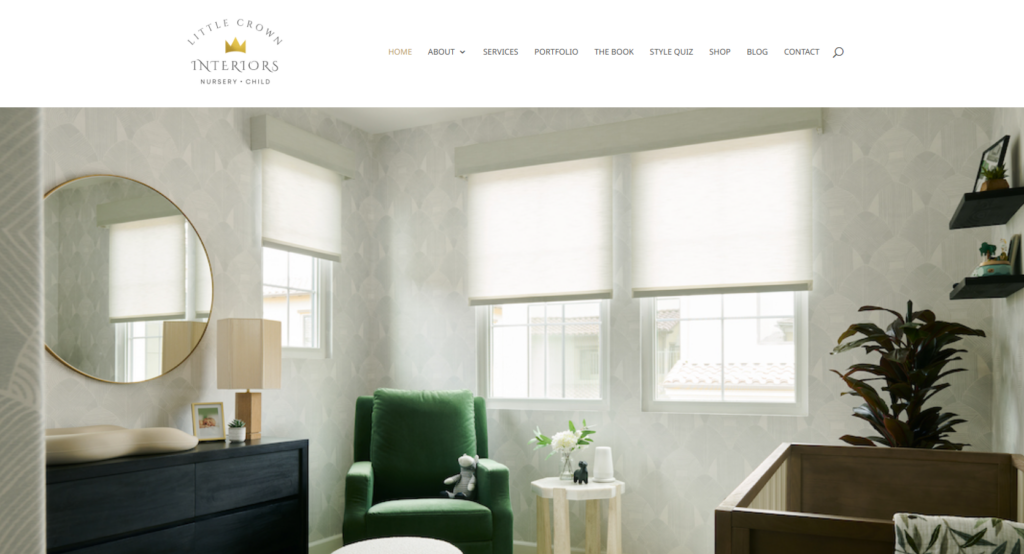
Little Crown Interiors is a nursery-focused design studio based in Orange County. The company offers virtual design services to satisfy clients across the US. With spot-on SEO optimization, the homepage of the website ranks for nursery interior design. Portfolio samples are also optimized to rank for themes, colors, and styles.
Keyphrases this website ranks for:
- Nursery interior design
- Baby room design
- Designer nursery
- Neutral safari nursery
3. Beth Haley Design
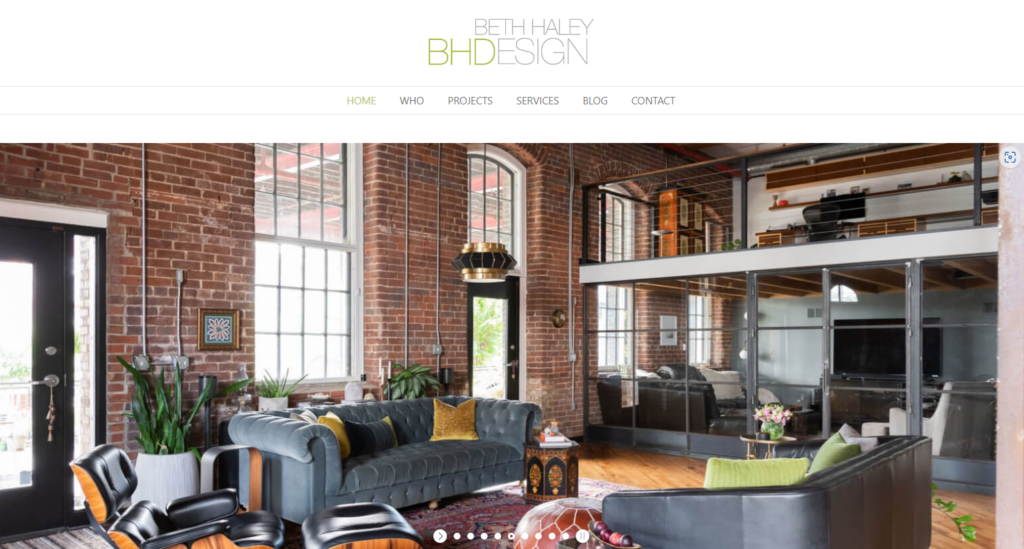
Through her blog and main website pages, Beth Haley of Beth Haley Design ranks for dozens of great keyphrases. Her home page is optimized for Nashville interior design, while her blog posts focus on bohemian design, serene spaces, and mid-century modern topics.
Keyphrases this website ranks for:
- Nashville interior designer
- Boho designers
- Kitchen design Nashville
- Mid-century modern interior designer
- Modern boho designer
SEO checklist for interior designers
By following these checklists, you can optimize your interior design pages and blog posts for better visibility and ranking on search engines.
Website Pages
- Keyword Research
- Identify primary and secondary keywords relevant to interior design.
- Use tools like Ubersuggest or Moz Keyword Explorer.
- URL Structure
- Ensure the URL is short, descriptive, and includes the target keyphrase.
- Example: www.yoursite.com/interior-design-services
- Title Tag
- Include the target keyphrase in the title.
- Keep it under 60 characters.
- Example: “Top Interior Design Services | [Your Company Name]”
- Meta Description
- Write a compelling meta description with the target keyphrase.
- Keep it under 160 characters.
- Example: “Discover our top-notch interior design services. Transform your space with [Your Company Name].”
- Header Tags (H1, H2, H3, etc.)
- Include the target keyphrase in the H1 tag (hero headline).
- Use H2 and H3 tags for subheadings, including secondary keywords.
- Content Optimization
- Ensure the content is informative and engaging.
- Naturally include the target keyphrase and related keywords.
- Aim for at least 500 words of high-quality content.
- Image Optimization
- Use high-quality images.
- Optimize images with descriptive file names and alt text including the target keyphrase.
- Internal Linking
- Link to other relevant pages on your site using keyword-rich anchor text.
- External Linking
- Include links to authoritative sources within your content.
- Mobile Optimization
- Ensure the page is mobile-friendly.
- Page Speed
- Optimize for fast loading times using tools like Google PageSpeed Insights.
- Regular Updates
- Keep your content updated and relevant by changing website text or adding a new section at least every 18 months.
Blog Posts
- Keyword Research
- Identify long-tail keywords relevant to your blog topic.
- Use tools like Ubersuggest or Moz Keyword Explorer.
- URL Structure
- Create a URL that includes the target keyphrase.
- Example: www.yoursite.com/blog/interior-design-trends-2024
- Title Tag
- Include the target keyphrase in the title.
- Example: “Top Interior Design Trends for 2024 | [Your Blog Name]”
- Meta Description
- Craft a meta description with the target keyphrase.
- Example: “Explore the latest interior design trends for 2024. Stay ahead with [Your Blog Name].”
- Header Tags (H1, H2, H3, etc.)
- Use the target keyphrase in the H1 tag.
- Use H2 tags for main sections and H3 tags for subsections.
- Content Optimization
- Ensure the blog post is informative and engaging.
- Naturally include the target keyphrase and related keywords.
- Aim for at least 1000 words of high-quality content.
- Image Optimization
- Include high-quality images and infographics.
- Use descriptive file names and alt text with the target keyphrase.
- Internal Linking
- Link to other relevant blog posts and pages on your site using keyword-rich anchor text.
- External Linking
- Include links to authoritative sources within your content.
- Mobile Optimization
- Ensure the blog post is mobile-friendly.
- Page Speed
- Optimize for fast loading times.
- Social Sharing
- Add social sharing buttons to your blog posts.
- Comments Section
- Enable comments to encourage reader interaction.
- Regular Updates
- Keep your blog content updated and relevant. Update old blog posts every 12-24 months (remove old years, trends, links, etc.) Add new blog posts monthly.
SEO keywords for interior designers
If you’re looking to enhance your online presence and attract more clients, utilizing targeted SEO keyphrases is essential. Below, we’ve got a curated list of interior design topics to inspire your blog posts and landing pages. Many of these keyphrases can work for designers, decorators, and architects.
By integrating these keyphrases into your content, you can improve your search engine rankings, drive more traffic to your site, and establish yourself as an authority in the interior design industry.
- [Location] interior designer
- Small space designer
- Virtual interior designer
- Sustainable interior design
- How to hire an interior designer
- Minimalist interior designer
- Luxury home interiors
- Mid-century modern decor
- Vintage interior design
- Scandinavian home style
- Eclectic home decorating
- Bohemian interior design
- Industrial home decor ideas
- Coastal living room inspiration
- Rustic farmhouse decor
- Contemporary kitchen design
- Bathroom renovation ideas
- Home office designer
- Open floor plan designs
- Cozy bedroom ideas
- Kids’ room interior designer
- Paint color consultation
- Interior lighting solutions
- Wall art and decor ideas
- Space-saving furniture
- Home organization hacks
- Seasonal home decor trends
- Feng shui home tips
- How to choose home paint colors
- Vintage furniture restoration
- Modern living room ideas
- Outdoor living space design
- Apartment interior design
- Eco-friendly home materials
- Home staging tips for selling
- Creative storage solutions
- Transitional home decor
- Art Deco interior style
- How to create a gallery wall
- Home renovation services
- Best indoor plants for decor
- Kitchen interior designer
- Smart home designer
- Wallpaper design trends
- How to mix patterns in decor
- Home textiles and fabrics
- Lighting design for small spaces
- Decorating with mirrors
- Interior design for pet owners
- How to style open shelving
FAQs about interior design SEO
For interior designers looking to boost their online presence, following basic SEO steps is essential. Start with keyword research to identify relevant terms that potential clients might search for. Next, strategically place these keywords on your website to enhance visibility. Then, optimize your site to ensure it ranks well for these chosen keywords. Prioritizing basic SEO early on can give you an edge, especially in less competitive markets. You can tackle more advanced SEO (like publishing monthly blog posts and acquiring backlinks) once you have a steady flow of leads from other sources.
Interior design websites offer tons of great opportunities for image SEO, meaning that you can rank your portfolio pieces in Google images. When uploading images to pages and blog posts of your website, make sure to add alternative text, also known as alt text, to describe the content of the image. Add descriptive details, such as “green and gold mid-century modern living room moodboard.” Also make sure to use descriptive file names such as “mid-century-modern-living-room” and to compress your images using free online tools like TinyPNG to lower the file size below 500KB.
To optimize your website for local SEO, make sure to choose location-based keyphrases for your website pages. For instance, if you live in Denver, Colorado, you might optimize your home page for “Denver interior designer.” Be sure to include that keyphrase in the top headline of your site as well as the meta description. You should also set up a Google My Business listing with your local business address and link that to your main website.
To create an SEO-friendly blog post about interior design trends, focus on incorporating relevant keywords naturally throughout the content, especially in headings and the first paragraph. Include high-quality images with descriptive alt text to enhance visual appeal and SEO. Ensure the post is well-structured with clear headings, subheadings, and bullet points for readability. Lastly, provide valuable and up-to-date information, linking to examples and embedding social media posts for easy imagery of current trends.
Conclusion
Yes, SEO is a bit technical. But no, it’s not impossible. In fact, many designers don’t rank in Google simply because they count themselves out of the game before they even try.
But showing up in Google is amazing. It offers free, targeted traffic. Plus, it portrays you as an authority.
Follow these steps, stay committed, and you’ll be getting more leads than you can handle. And not just any leads—ones who are actively looking for a designer and who see YOU as the expert.
Check out DesignFiles for easy design tools, an active community of interior designers, and lots of helpful content.


![Average Interior Designer Salaries in 2025 [Plus How to Earn More!]](https://blog.designfiles.co/wp-content/uploads/2022/10/interior-designer-income-salary-768x439.jpeg)